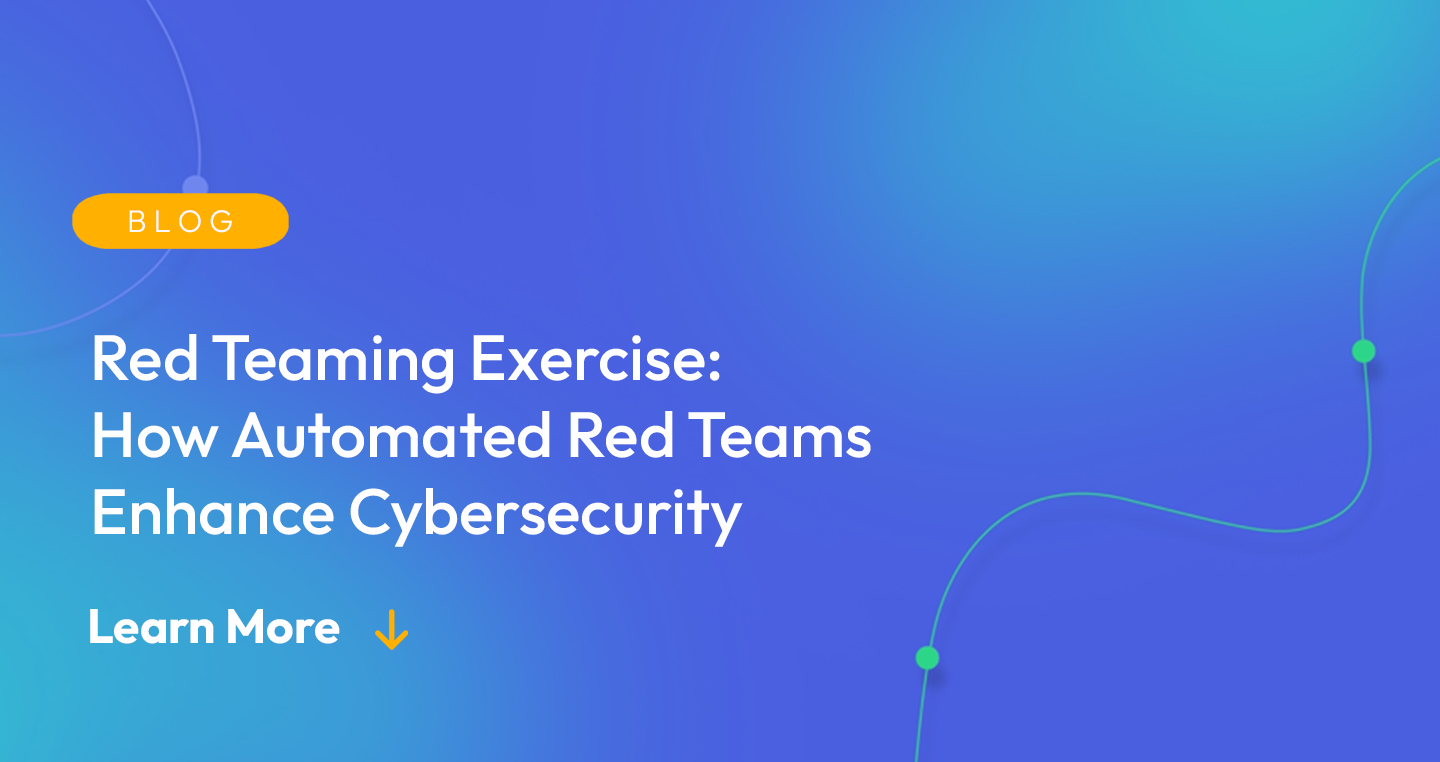
In today’s ever-changing threat landscape, employing security-based testing is more important than ever before. As organizations continue to rely on the latest technology to execute their daily business operations successfully, the risk of cyberattacks only continues to increase exponentially. For this reason, countless companies are turning to conducting red teaming exercises against their systems and infrastructure in order to better identify vulnerabilities and weaknesses within their security procedures.
While red teaming exercises have been a part of cybersecurity testing for many years, it is only recently that these exercises have been more streamlined thanks to better automation capability. This rise of automation in many sectors of security has become an increasingly popular and valuable option for countless organizations and their teams. In this post, we’ll cover what red teaming exercises are, whether conducting one is right for your team, how to execute a successful exercise, and how automated red teaming could benefit your security posture effectively.
What are Red Teaming Exercises?
Red teaming exercises are simulated attacks that are conducted by threat intelligence professionals in order to aid organizations in testing their security systems and pinpointing vulnerabilities. The primary aim of conducting a red team exercise is to emulate the real-world tactics, techniques, and strategies of an attacker in order to determine the probable weaknesses in your security posture.
The goal of conducting a red teaming exercise will often involve a comprehensive and mock cyberattack with the purpose of testing your system defenses, internal incident response, and identifying areas that require improvement for better security. These testing methods are also designed to provide businesses the opportunity to see just how vulnerable or secure their digital infrastructure can be. It can be especially important to test against the continuously growing amount and sophistication of cyberattacks companies may regularly see within their industry.
These testing measures also help with specifying any security gaps while also providing insights into the effectiveness of your company’s security policies, procedures, and technologies. In the past, most red teaming exercises have often been done with support from third-party red team vendors or internal red teams. However, many teams both internal and externally nowadays have benefited from support of more automated red teaming testing. The beneficial results of these exercises can be used to prioritize security investments, allocate the resources more effectively, and improve overall cybersecurity readiness and response successfully.
Should My Organization Conduct a Red Teaming Exercise?
Many organizational leaders will sometimes be uncertain whether a red teaming exercise will be worthwhile for them to perform for their company. Red teaming exercises are an offensive type of cybersecurity and involve a more complex, lengthy, and costly type of security testing. This is because red teaming exercises focus more on the greater organizational infrastructure or a more extensive section of the company’s system and network security. Also, many red teaming exercises are often nowadays with external teams thanks to the benefits of remote access and automated testing capabilities.
Deciding whether your business should conduct a red teaming exercise in order to test the company’s defenses will depend on your specific security objectives and needs. When determining if a red teaming exercise will benefit your company, there are several factors to consider when making that decision. Here are a few questions and realistic scenarios to consider when deciding if a red-teaming exercise will be right for your company:
What is the nature of your organization and the regulatory compliance requirements of your industry?
When determining if a red teaming exercise is right for your organization, it will be valuable to take a greater look at some of the cyber threats that your company can face within your industry. For example, companies that have access to customer and client payment information directly can face more fines and penalties if consumer data privacy is breached. Other industries, like the energy sector, can face operational hazards to citizens and employees if their systems are compromised successfully.
What do your current corporate security infrastructure procedures and policies look like already?
Red teaming exercises can often be more beneficial to smaller organizations and high-risk companies that face a multitude of threats regularly. For instance, many larger organizations already have security and IT teams dedicated to supporting the company’s security initiatives and practices. Therefore, a red teaming exercise that focuses on a wider security picture may not be as critical if your organization already has a more robust security posture.
What is your ideal timeframe and budget?
Many organizations may often not be aware that a red team exercise can be more expensive to conduct and also can be a lengthier process depending on the testing done. This cost can vary between risk levels of your company and the automation capabilities that can aid the red teaming exercise successfully. This is where gathering an idea of your comprehensive testing need and scope will need to be determined internally in order to explore your budget for the red teaming exercise to be executed within your company.
Elements of a Successful Red Teaming Exercise
Red teaming exercises can be beneficial to organizations of all sizes. It can also be valuable for industries and sectors that have more cyberattacks and risks associated with them. There are several elements that you can factor into executing a successful red teaming exercise. Below are four core elements of what a successful red team exercise may look like for your company.
1. Objectives – a key element of successful red team exercise within your organization includes having a clearly defined set of goals and objectives for the testing. These objectives for the exercise should also include a clear roadmap of the core initiatives for the team and active communication between leadership, stakeholders, and teams.
2. Reconnaissance and rules of engagement – red teams and the organizations they work with for the exercise often need to establish rules of engagement for the testing in order to conduct a successful red teaming exercise. This can include specific areas to test, what to test, tools and methods to use both legally and ethically. Red teams and leadership also will need to ensure the information regarding the company employees, systems, and networks to include in the testing is accessible to the red team. This helps them with being able properly to conduct a thorough test to identify vulnerabilities for the exercise to be done successfully.
3. Attack simulation – the most successful red team exercises should simulate attacks that are realistic and tailored to the organization being tested. This includes using a variety of techniques, tools, and methods to test the effectiveness of the organization’s security controls. Also, the scenarios included within the attack simulation should be specific to the threats that organizations may face directly versus broad and cross-sector attack vectors that many industries face. For example, a successful red team exercise for a retail company can include red teaming exercises regarding consumer payment information. Whereas, a medical office may benefit more from a red teaming exercise focused on internal patient data security.
4. Report and response – successful red teaming exercises are often more in depth than other forms of vulnerability testing models. Most red teaming exercises include a comprehensive report of the summarized approach of the testing and the findings. They often present this report to leadership and technical staff with provided recommendations and areas of improvement for the organization’s policies, security controls, and incident responses.
Red Teaming Exercises and Automation
As more companies look to red teaming exercises to increase their overall security, there are many ways that teams can automate their red teaming exercises successfully. When employing an automated red teaming exercise, the teams can use a combination of automated tools and techniques to simulate attacks against an organization’s systems, applications, and processes. Automation allows these teams to better simulate the real-world attack vectors that the cybercriminals could use in order to gain unauthorized access to a company’s systems and networks.
The automated capabilities of red teaming exercises such as automated vulnerability testing and phishing campaigns have helped countless businesses conduct red teaming exercises successfully. For instance, many companies can hire internal red teams to help execute these attack simulations and tests successfully. Internal red teams can use social engineering tactics to see if employees will compromise systems or share private company data freely.
In today’s world, the cyber threats countless consumers and businesses face are becoming increasingly complex and sophisticated. It is more important than ever for organizations to take proactive measures to safeguard their system and network security and the data contained within them. By leveraging the capability of automated tools and techniques, organizations can gain insights into their security posture.
Using red teaming exercises to conduct testing against your systems can provide valuable insights into where vulnerabilities lie and where more security is necessary. Red teaming exercises, whether conducted internally or by a third-party vendor, can help you become better prepared to defend against the growing cyber threats of today’s digital landscape.
How Flare’s Automated External Risk Monitoring Can Help
External risks can be detrimental to an organization’s overall cybersecurity. Without instituting a red teaming exercise against your vulnerabilities and weaknesses, many companies may not know the real threats they may face.
Flare can help you ease that insecurity within your company. By using Flare, we can help you automate and safeguard your company with your external attack surface. Contact us today to get a free demo.





